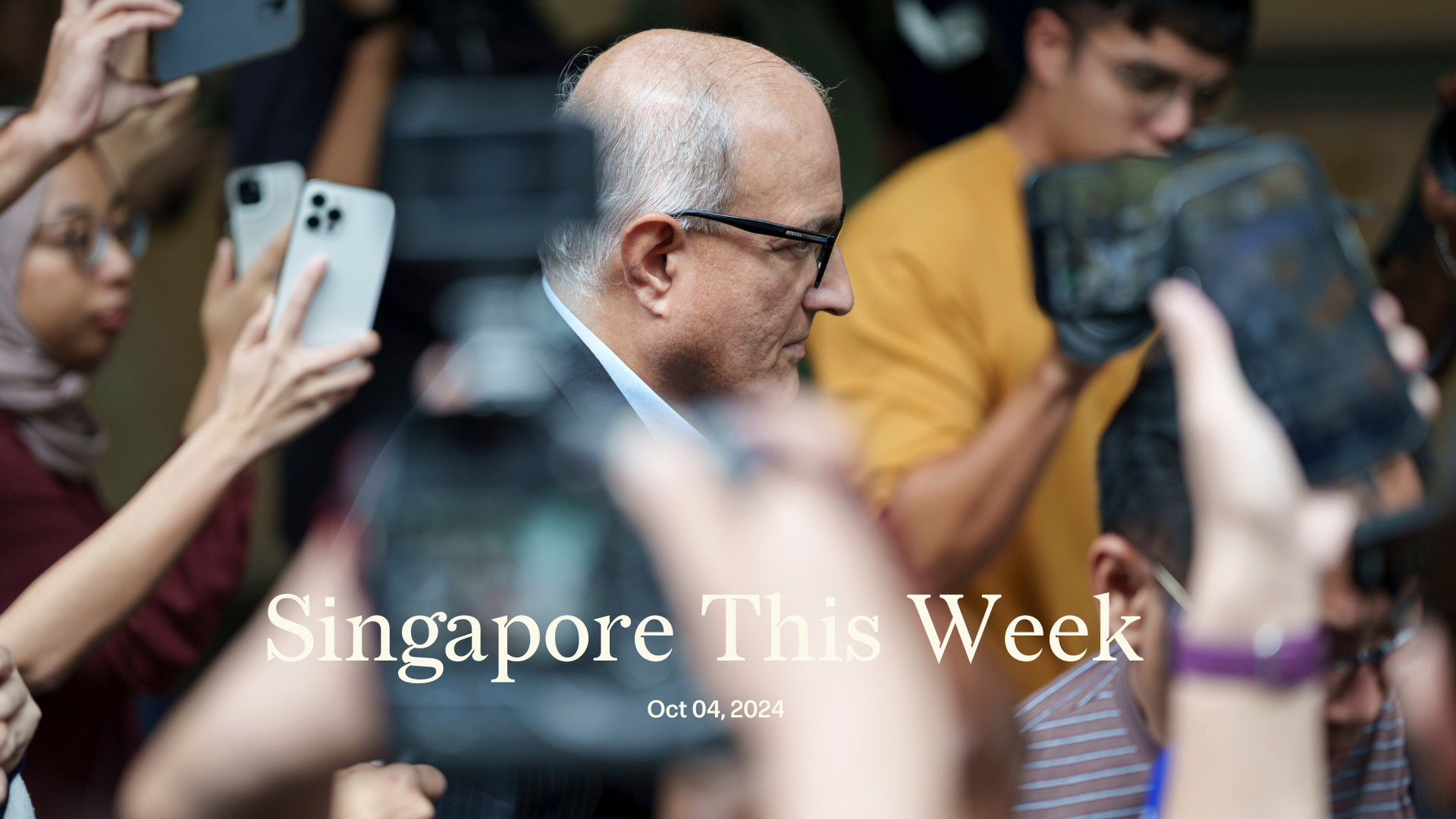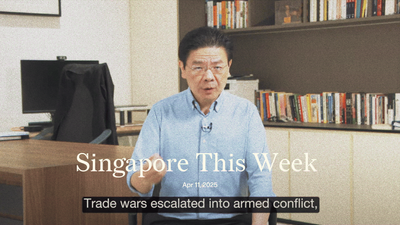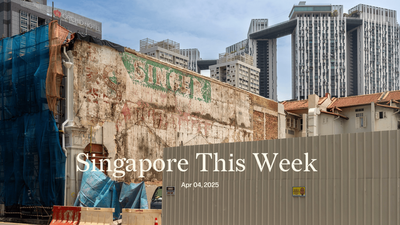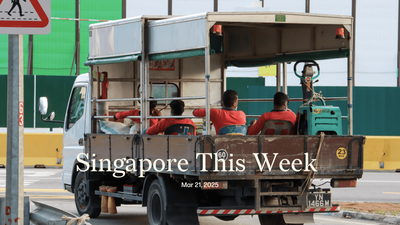Politics: A year in the slammer for Izzie
Vincent Hoong, high court judge, surprised much of Singapore by sentencing S Iswaran, former minister, to 12 months in jail, after he pleaded guilty to the greatly reduced charges of obtaining gifts as a public servant and obstructing justice. The prosecution sought six to seven months while the defence wanted eight weeks, both of which Hoong said were “manifestly inadequate”. The judge cited Iswaran’s behaviour after first having been charged—including a letter to Lee Hsien Loong, then prime minister, in which he rejected the charges, said he was innocent, and expressed his belief that he’d be acquitted—in arguing that it’s difficult to accept that Iswaran is remorseful. “In my view, the accused, having made the tactical choices which he did at the initial stages of the proceedings, must stand by the consequences of those choices.”
He also said that “...the accused’s record of service and contributions to the nation, while substantial, is at best a neutral factor.” Lawrence Wong, current prime minister, reiterated this in a statement following the sentencing. “But his past contributions do not right this wrong. As painful as it is to act against a colleague and friend, it is our duty to do so when necessary.” Iswaran hasn’t said if he’ll appeal the sentence.
Hoong’s judgement sheds light on numerous aspects of the case, including how the Corrupt Practices Investigation Bureau (CPIB) first sniffed trouble. Sometime around May 17th 2023, it was investigating a separate matter related to Ong Beng Seng, Singapore’s corporate lead on the Formula 1 (F1) enterprise. It got hold of the flight manifest of a Singapore-Doha private jet flight on December 11th 2022, on which Iswaran had travelled for free as Ong’s guest. Ong then told Iswaran that the CPIB had it. And around May 25th 2023, Iswaran paid Ong S$5,700 for the flight, taken over five months prior. Hoong said that “the accused knew at the time that this act was likely to obstruct the course of justice.” For more on the almost S$8,000 Brompton bicycle, the exclusive “Green Room” tickets at F1, French wines, Scottish whiskies, and Iswaran’s conduct leading up to the trial, the judgement is worth reading in full. Ong will be charged today.
Politics: Vast majority believe our democracy and government need improving
What does democracy mean to Singaporeans? Free and fair elections; the provision of basic necessities like food; law and order; and clean and corruption-free politics. These are the most important dimensions of democracy here over three waves of the Asian Barometer Survey, whose Singapore edition has been conducted by the Institute of Policy Studies (IPS) since 2010. IPS, in releasing the 2023 results last week, concluded that Singaporeans value the procedural, substantive and good governance aspects of democracy, but place less emphasis on political-civic rights, such as media freedoms and the right to protest. (Though the framing of that forced-choice question, as IPS acknowledged, has its limitations.)
In the past week, much media reporting of the results has focused on the uptick in Singaporeans who feel that they’re living in a “full democracy” (12.4 percent) versus in 2020 (9.2 percent). But if one looks further back, beyond that pandemic year, there are signs of a democratic decline. In 2010, for instance, over 80 percent of Singaporeans felt that Singapore is a full democracy or one with minor problems. By last year, this had fallen to under 75 percent. (Conversely, the share who believe it’s not a democracy or one with major problems has grown.) Similarly, in 2010, a whopping 37.8 percent of Singaporeans said that our government is working fine and needs no change. This dropped to 20.9 percent last year. Some 58.2 percent now believe the government needs minor change, 8.6 percent think it needs major change and, for the first time, over two percent believe the government “should be replaced”.
Singaporeans’ aversion to authoritarian scenarios, such as getting rid of elections, is strong, though not as intense as in 2006. Since the survey began that year, Singaporeans have consistently said that economic development is more important than democracy. Encouragingly, for the first time, only a minority of respondents said so last year: 25.6 percent said it’s definitely more important; 22.6 percent said it’s somewhat more important. A plurality (28.3 percent), for the first time, said they are equally important, while small segments said democracy is more important. Like any survey, findings should be taken with a pinch of salt, and one’s interpretation is prone to bias, though that last trend gives us cause for joy.
Society: The Bogieman cometh
The Land Transport Authority (LTA) has launched an investigation and appointed an expert advisory panel as the fallout from the longest-ever continuous disruption to a train service in Singapore continues. The saga began on September 25th when an empty train’s axle box and bogie—a part of the undercarriage—dislodged, causing major damage to the tracks along a 1.6km stretch between Clementi and Dover stations. Service was restored only on October 1st. More than two million commuters were forced to take longer routes or other means of transport, and transport personnel, from MRT ground staff to bus drivers, came under immense pressure as they dealt with much bigger crowds than usual.
For the authorities, the timing was terrible, coming as it did just over a fortnight after a fourth successive annual fare hike was announced; just over a week after another, relatively minor, disruption on the Circle Line; and a day before the dreaded primary school leaving examination (PSLE) commenced. And it’s not even been a year since the LTA announced the completion of its decade-long programme to upgrade and renew the North-South and East-West Lines which included among other systems, the train fleet, and cost billions in taxpayer money. Perhaps in mitigation, operator SMRT said that the faulty train was a first-generation vehicle, 35-years-old. Christopher Tan, former senior correspondent (Motoring & Transport) at The Straits Times (ST), was having none of it. “…[T]he fact that an operator puts a train in operation means it is deemed trackworthy, no matter its age.” SMRT chairman’s warning last year against “overmaintenance” hasn’t aged well.
Communication wasn’t great either. On the disruption’s second day, September 26th, the authorities rolled back plans to start partial services the next day, in favour of faster restoration of full service. Full service itself was pushed back by a day after 12 new track cracks were discovered. A Reddit wit said: “Westies that work in CBD: Wake me up when September ends.”
Disruptions to large systems are not uncommon, and Singapore’s public transport is largely very good. And yet, the pedestal on which the state places itself, and the amount of power it arrogates for itself in return for lofty promises of a slick, modern-day Valhalla is an invitation for intense public scrutiny whenever a major malfunction occurs. The opposition has yet to really get stuck in, as it did after disruptions in 2011 and 2015. To LTA’s credit, its panel includes international experts from London, Hong Kong, and Shanghai. No ownself check ownself this time.
Society: Another cultural staple on the brink of erasure
Before the convenience store, and before the mom-and-pop minimart, there was the mamak, or mama shop—a nook, usually found in HDB void decks, packed to the rafters and spilling out into the periphery with treasures and trinkets of all kinds: eatable, drinkable, cookable, readable, playable, wearable and even, collectible. But ballooning operating costs and lower foot traffic have led to their decline since their peak in the 1980s and early 1990s. They were traditionally owned and operated by Indians, hence “mamak”, the Tamil word for “maternal uncle”, and also a person of Tamil Muslim origin. (Not to be confused with mamak street stalls and restaurants in Malaysia selling Indian Muslim food.)
In the latest report of its impending demise, one mamak shop owner of some 30 years, Jannathun Abdul Hamid, told ST: “The supermarket is so near, and it sells more things, so people don’t need us that much any more.” Earnings have also dropped by more than half since it opened, she said. Kelvin Lim, second-generation owner of 40-year-old Hwa Lee Provision Store, has also seen sales dip: “...[P]eople now read and buy things online, and there are so many convenience stores near train stations.” Lim is “very tired”, has been unable to find a reliable replacement, and so may have to shutter his shop soon.
It may seem like a natural end to small family-run enterprises. Inflation, GST hikes, rising rents, higher material costs, owners retiring without an “heir apparent”; all conspiring to sound the death knell on traditional businesses. But will we mourn too late the loss of our hawkers, furniture makers, cobblers, provisions stores, Chinese medicine halls, and mamak shops? These trades and businesses do more than sell goods and provide services. They form an integral part of Singapore culture—where else would one find “Kelvin Lim” and “mamak” in the same sentence—and bring economic diversity into our neighbourhoods. Why we should be concerned about the closing of another mamak shop has less to do with nostalgia, but the erasure of place, “the personality of a location”. And along with it, the social history of the space, as well as the generational trust and bonds established in the community. Consumers everywhere are thinking harder about ethical consumption. Our mamak stalls can thrive only if we shop there.
Some further reading: in “Fosters and Holland V: belonging, change and loss in Singapore”, Zachary Hourihane asks what it means to belong as Singapore’s landscape continues to shift and change.
History weekly by Faris Joraimi
In a viral TikTok video, Madam Sng Mui Hong, the current landlady of Kampung Lorong Buangkok vowed that she would never sell the kampung’s land, despite it being valued at S$70m. Singapore’s last rural settlement, Kampung Lorong Buangkok was founded in 1956 when Sng Teow Koon, seller of traditional Chinese medicines and Mui Hong’s father, purchased land on the banks of the Punggol river (Sungai Punggol), and rented out lots for families to build houses, attracting a mix of Chinese and Malays. Like most other kampung houses in Singapore, these would have been built based on plans submitted to, and approved by the municipal authorities. They were not haphazardly built huts in a “slum”. Speaking Malay with a near-flawless accent, and intoning her sentences with the proper stresses, Sng Mui Hong narrated her father’s words. Before he passed away, the elder Sng had told his daughter never to sell the land he bought to ensure his children and grandchildren would want for nothing; to go back on this promise will be a big sin (dosa besar), even if it made her rich.
Today the kampung, also known as Kampung Selak Kain (“lift up your sarong”) because of its frequent floods, is considered a portal to a vanished Singapore. Beyond the warm nostalgia, however, everyone seems resigned to a future where this last holdout disappears. If not by sale, then by state acquisition: the URA’s 2008 master-plan earmarked the site for a road. I won’t romanticise bucolic idyll. I’m sure the kampung has its feuds like any other community, and there can be strong neighbourly bonds among supposedly depressed and atomised HDB high-risers. But there’s a lot about Lorong Buangkok that captures the imagination. It’s not only the stark visual contrast it represents to everything else on the island. It’s also a meaningful community in ways that are seemingly improbable inside the Singapore we know. Sng’s legal relationship to the land is one of property, sure: but it’s not profitable. In fact she often accepts fruit or rice as payment in kind. Sng’s relationship to the residents is not transactional; they are “like family” to her. The community is multicultural: like all kampungs, it has a Malay penghulu, Awe Bin Ludin, who has authority without owning the land. This is a place where a promise probably has more value than cash, where Malays and Chinese are creating a shared experience and history as a voluntary, mutually-beneficial project, not because of government quotas. “As long as I have enough to eat,” said Madam Sng, “I don’t hunger after money or to be rich.” With a community like that, she’s probably the richest among us.
Arts: The people’s architect
Singapore is, perhaps, one of the few places where an architect might outlive his creations. Alfred Wong, a master of modernist architecture, who frequently found poetry in geometry, died last week aged 94. He is survived by many of his buildings: Singapore Polytechnic’s (SP) Dover Road campus, with its expandable grid system and bright yellow fibreglass sheltered walkways. The Church of St. Bernadette, where he choreographed greater liturgical participation by narrowing the distance between entrance and altar, a strategy of “perspectival foreshortening” that modern Catholic churches were only just beginning to adopt.
But at least two beloved projects went before he did. The Hotel Malaysia (later the Omni Marco Polo Hotel) at Tanglin Circus, which hosted everyone from Cliff Richard to Roger Moore: its unadorned white exterior giving way to an opulent interior embellished with jade, onyx, marble and teak. It’s since been replaced by Grange Residences. And, of course, the National Theatre: its stunning 150-tonne cantilevered roof sweeping the slope of Fort Canning Hill, culminating in a dramatic facade of five vertical diamond-shaped bays and a crescent of an outdoor fountain. Before it gave way to the Central Expressway in 1986, the 3,420-seater was affectionately known as “the people’s theatre”; the public poured money into its “a-dollar-a-brick” campaign in the early 1960s. The National Theatre lives on in the tessellated diamond patterns on the walls of Wild Rice’s Ngee Ann Kongsi Theatre, which pay homage to its architectural and theatrical ancestry.
The towering architect often played down his ability to marshal the movements of people. Hotels, churches, theatres—many of Wong’s spaces were places of ritual and replenishing. But there were also invisible struggles. His autobiography, Recollections of Life in an Accidental Nation, recounts how his firm had initially proposed a central campus for SP, but the design was rejected for fear of student protests. They went with a more diffuse and distributed layout, which formed the basis of what we see today—not unlike other design approaches to tertiary campuses in Singapore.
In his tribute to Wong, Darren Soh—the critically acclaimed architectural photographer who has long captured and catalogued Singapore’s built environment—celebrated the public figure’s most private work: his own home. Soh, on assignment for Singapore Architect, photographed the space in 2018. Wong was initially reluctant, concerned that Soh would misrepresent it: “He was quite aghast at the idea that the proportions of his house may be distorted (both figuratively and literally) should I just put on an Ultra-Wide Angle lens to do the shoot. In the end, I promised [him] I would use no wider a lens than my 24mm tilt shift...I got my stamp of approval and he managed to keep the representation of his home distortion-free.” Let’s hope Wong’s legacy remains as such.
Arts: Pasar Glamour takes a bow
“Survival is a creative act,” goes the potent aphorism from Suleika Jaouad, the award-winning writer and cancer survivor. Cancer and creativity birthed the long-running charity bazaar Pasar Glamour, but it’s also cancer and the need for creative rejuvenation that are bringing it to a close. Janice Koh, Petrina Kow and Pam Oei—a trio of actresses and good friends—have been selling pre-loved luxury goods for a good cause since 2017, raising close to half a million dollars for over 200 individuals and 18 organisations. They told ST that the annual fashion pop-up began as a way to both “honour and respectfully rehome” clothing left behind by the late Emma Yong, a luminous actress known for her ingénue roles, who died from stomach cancer in 2012, aged 37. But the same disease that took Yong too soon also caught up with Pasar Glamour’s co-founders. Kow was diagnosed with nasopharyngeal cancer in 2020; two years later, Koh got a tongue cancer diagnosis. They’ve both since completed treatment and are in recovery, but one of the bazaar’s regular volunteers didn’t. Tay Shan Min, a former communications professional, died of nasopharyngeal cancer last year. The late fashion lover bestowed most of her designer wardrobe to the bazaar. Kow told ST, “When we saw it, we were like, okay, I guess this means we have to do a sale.”
This final sale will take place this weekend at Enabling Village, an inclusive community space for persons with disabilities. Every Fendi, Hermès and Dior you add to your collection will benefit groups such as Arc Children’s Centre, a cancer foundation, and the Association of Women for Action and Research (AWARE), the women’s rights and gender equality advocacy group. Pasar Glamour was one of the local frontrunners occupying the designer space in the pre-loved and slow fashion movements. Since then, other platforms and communities have taken up the mantle, including Fashion Revolution Singapore and Singapore Fashion Runway, advocating for reduced consumption and circular clothing economies. Beloved friends Tay and Yong will live on, it seems, through their lived-in clothes.
Tech: An ocean of opportunity for Sea in Thailand
The Singaporean tech conglomerate Sea Group is known for owning e-commerce site Shopee and gaming development platform Garena. It has a financial services arm too: SeaMoney. Since launching in 2014, SeaMoney has started digital banks in Indonesia, the Philippines and Singapore, and offers other financial services in six South-east Asian markets. It recorded a 44 percent increase in revenue in 2023 to US$1.8bn (S$2.3bn), and a US$550m (S$713.3m) profit compared to a US$228m (S$295.7m) loss the previous year. Now, the company has set its sights on Thailand. In a significant step towards digitalisation of financial services in the region, South-east Asia’s second-largest economy is opening its doors to virtual banks. SeaMoney has applied for a licence, in partnership with prominent local companies like Bangkok Bank, BTS Group, Saha Group and Thailand Post. Licence winners will be announced by mid-2025, with operations expected to start about a year later.
Digital payments and lending are expected to grow substantially by 2030, and virtual banking holds the promise of greater innovation and wider inclusion. Yet, it’s a challenging business due to high initial investments and intense competition. Thai authorities did not reveal the other four parties who had applied for licences but likely candidates include the CP group, which runs 7-Eleven convenience stores across the country, as well as other consortiums headed by powerful local banks and tech companies. No matter who gets the licences though, consumers could benefit from the increased competition.
Tech: Building a safer smart nation
It has been almost 10 years since Singapore first launched its Smart Nation strategy, focusing on “building up capabilities and encouraging the use of technology”. At the time, snaking queues at the ATM were common, cashless payments rare, and government services like passport renewal time-consuming. Today, technology has alleviated many of these problems, but new opportunities and challenges have emerged. Building on Smart Nation 1.0, Lawrence Wong, prime minister, has launched Singapore’s Smart Nation 2.0 initiative. This update focuses on three key areas: Growth, Community, and Trust. A new government agency will be set up to address online harm like cyberbullying and revenge porn.
This agency, inspired by Australia’s eSafety Commissioner model, will have the authority to investigate and act on various forms of online abuse and illegal content. The aim is to provide faster, more effective recourse for victims, addressing the limitations of current legal processes and the unresponsiveness of service providers. The need for such an agency was reinforced by a recent survey that found that eight in 10 of respondents who reported online harms faced issues with the process.
If you enjoy Jom’s work, do get a paid subscription today to support independent journalism in Singapore.
Addition: soon after publishing, we added in more context to the question of economic development versus democracy in the Asian Barometer Survey blurb.






